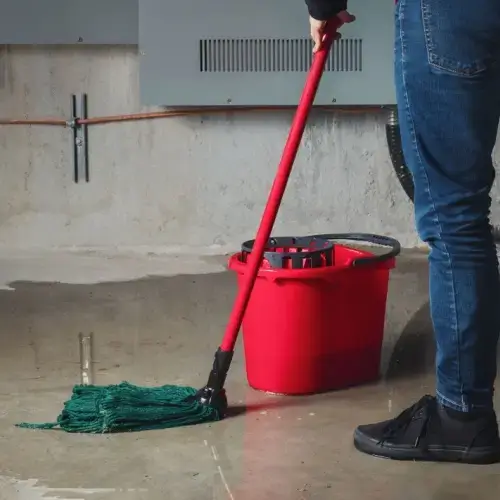Home / Compare Home And Content… / Home insurance for water…

Key takeaways
- Whether it’s coming from an appliance, shower or heating system, escaped liquid can do serious damage to your property and its contents.
- Most home insurance policies will only cover you for water damage that occurs under specific circumstances.
- Property-owners can reduce the risk of their property becoming water-damaged through regular maintenance and upkeep.
Expert tips about water damage for property-owners
Our home insurance expert, Adrian Taylor, has some tips for homeowners to help them understand the risks posed by water damage and what protection their cover can provide:

Understand what ‘escape of liquid’ means
‘Escape of liquid’ typically means the spontaneous escape of enough liquid to cause immediate damage to your property or its contents. Damage caused over time by a small leak will typically not be covered under your insurance policy, as it could be considered general wear and tear and gradual deterioration.
Flood damage is not the same as water damage
Insurers treat flood damage as a specific kind of water damage and a separate category of cover to standard water damage. While your home insurance policy may include cover for water damage caused by an escape of liquid, flood damage may either be standard or offered as an optional extra. It is important for a policy holder to understand the difference between the two and check whether you’re covered for both eventualities.
It's important to be proactive
Even if your policy covers you for water damage, you’ll need to be able to prove any damage caused wasn’t due to neglect or wear and tear. Conduct regular checks and, if necessary, do maintenance work to keep your household and its fixings in good condition.
Understanding water damage
What is water damage?
In insurance terms, water damage is any damage or degradation caused to your property or its contents by the accidental release of water from something like (but not limited to) your washing machine, dishwasher, toilet, heating system, pool, or a water main.
What can cause water damage?
Water damage typically occurs in one of two ways:
- A significant amount of water being released at once and causing immediate water damage to the fixtures and parts of your property
- The frequent release of a small amount of water, causing water damage over a longer period. This may be caused by poor maintenance or normal wear and tear of fixtures like taps.
However, some water damage can be caused by both of the above scenarios. For example, a water pipe could rupture and dump litres of water into your home, but the initial rupture could have been caused by long-term neglect causing rust or degradation of the pipe.
What qualifies as ‘escape of liquid’?
For insurance purposes, ‘escape of liquid’ is generally defined as liquid leaking, overflowing or bursting from a fixture or fittings within or on your property. The list of covered apparatuses may vary by insurer, but typically includes things like whitegoods, drains, pipes, water tanks, pools, heating or cooling systems, and more.
Insurers will typically have a list of excluded causes and scenarios which won’t be covered for water damage – check your insurer’s Product Disclosure Statement (PDS) to see what their escape of liquid-related exclusions are.
Home insurance for water damage
Does home insurance cover water damage?

A home insurance policy will typically provide cover for water damage to the property or its contents in the event of an escape of liquid. The escape of liquid will generally need to be sudden or accidental, and not attributable to general wear and tear.
If the damage is due to wear and tear, in most cases the insurer likely won’t pay your claim – as the insurer would view the damage as being caused by long-term degradation, rather than a spontaneous escape of liquid. This determination will be made following the investigation of the claim.
It’s important to note that a home insurance policy covers damage to the structural components of your home, while a contents insurance policy covers damage to your belongings within the home. A combined home and contents insurance policy could cover the replacement of damaged contents, as well as the repair of any damaged walls or floors.
How do I know if I’m covered for water damage?
To check the level of water damage your home insurance policy affords you, check the PDS. The PDS’s ‘Escape of liquid’ section will show you what types of water damage are and aren’t covered, and include a detailed list of included and excluded water damage scenarios.
Whether you’ve insured a building or contents in an apartment, your insurance policy should provide some level of cover for water damage.
What to do if your home is damaged by water
What do I need to do in the event of water damage?

If your property suffers water damage, your first step should be to prevent further damage if it’s safe to do so. For example, if your washing machine is overflowing, turn it off and try to stop more water escaping from the appliance.
You’ll also want to document the damage as extensively as possible. Take photos and videos of the damage, what’s caused it and exactly what happened. You may be required to provide documentation proving ownership of the damaged goods.
You’ll also want to contact your insurer as soon as you can to make your insurance claim.
How to make a water damage claim
To lodge a water damage claim, have your policy number and documentation of the water damage handy and contact your insurer either online or by phone. Some insurers may also have a mobile app you can use to lodge a claim.
Your insurer may send an assessor to inspect the damage before approving your claim. Make sure you talk to your insurer if you are considering fixing the damage before the assessor’s inspection. If your claim is approved, your insurer will typically arrange for replacement items or the required repairs to be completed.
Ways you can lower the risk of water damage to your home
While it’s hard to protect your property from a spontaneous escape of liquid, there are several steps you can take to prevent water damage over a longer period of time, including:
- Regular inspection of water pipes and flexi-hoses in your property
- Checking walls, floors and ceilings for early signs of water damage
- Turning off the water supply to your home if you’re away for an extended period.
If you suspect you have a leak somewhere in the house, turn off all of your property’s taps and hoses and check your property’s water metre. After an hour or so, check the metre again. If the reading has changed, there’s probably a leak somewhere.
Meet our home and contents expert, Adrian Taylor
As a General Insurance expert with over 13 years’ experience in financial services, Adrian Taylor works to make it easier for homeowners, renters and landlords to protect their home and contents. He believes it’s important for all residents (whether they rent, own or lease) to have adequate financial cover for their property and belongings in case the worse should happen.


